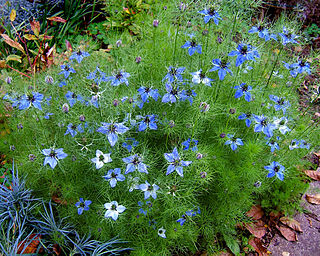
Nigella damascena, love-in-a-mist, ragged lady or devil in the bush, is an annual garden flowering plant, belonging to the buttercup family Ranunculaceae. It is native to southern Europe, north Africa and southwest Asia, where it is found on neglected, damp patches of land.

Lavandula angustifolia, formerly L. officinalis, is a flowering plant in the family Lamiaceae, native to the Mediterranean. Its common names include lavender, true lavender or English lavender ; also garden lavender, common lavender, and narrow-leaved lavender.
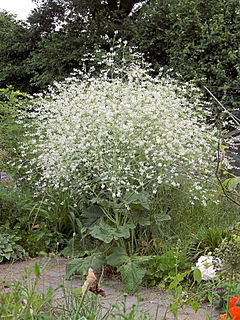
Crambe cordifolia, the greater sea-kale, colewort or heartleaf crambe, is a species of flowering plant in the family Brassicaceae, native to the Caucasus. It has gained the Royal Horticultural Society's Award of Garden Merit.
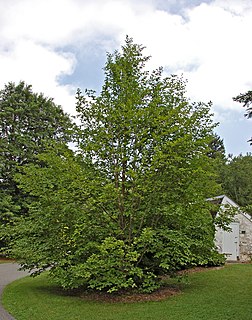
Stewartia pseudocamellia, also known as Korean stewartia, Japanese stewartia, or deciduous camellia, is a species of flowering plant in the family Theaceae, native to Japan and Korea.

Santolina chamaecyparissus, known as cotton lavender or lavender-cotton, is a species of flowering plant in the family Asteraceae, native to the western and central Mediterranean.
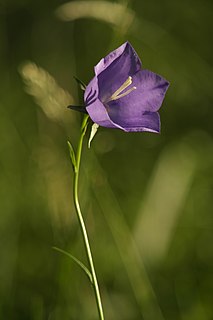
Campanula persicifolia, the peach-leaved bellflower, is a flowering plant species in the family Campanulaceae. It is an herbaceous perennial growing to 1 m. Its flowers are cup-shaped and can be either lilac-blue or white. Its foliage is narrow and glossy with a bright green appearance.

Genista aetnensis, the Mount Etna broom, is a species of flowering plant in the legume family Fabaceae. It is a large shrub or small tree endemic to Sicily and Sardinia where it is associated with sunny, open landscapes and poor, stony soil. It is a very common constituent of the garigue plant communities, Mediterranean shrubby vegetation, around the lower slopes of Mount Etna, hence its Latin specific epithet aetnensis.

Sorbus sargentiana, Sargent's rowan is a species of flowering plant in the family Rosaceae, native to southwestern Sichuan and northern Yunnan in China, where it grows at altitudes of 2,000–3,200 m (6,560–10,500 ft).

Farfugium japonicum is a species of flowering plant in the family Asteraceae, also known as leopard plant, green leopard plant or tractor seat plant. It is native to streams and seashores of Japan, where it is called tsuwabuki (石蕗).

Ligularia is a genus of Old World herbaceous perennial plants in the groundsel tribe within the sunflower family. They have yellow or orange composite flower heads with brown or yellow central disc florets, and are native to damp habitats mostly in central and eastern Asia, with a few species from Europe. There are about 120 to 140 species in the genus, and over half are endemic to China. The name Ligularia, from the Latin for "strap", refers to the shape of the ray florets.

Gypsophila repens, the alpine gypsophila or creeping baby's breath, is a species of flowering plant in the family Caryophyllaceae, native to the mountains of central and southern Europe, where it grows on dry, chalky slopes. The Latin name literally means "creeping chalk-lover". It is a prostrate, mat-forming herbaceous perennial, growing around 20 cm (8 in) tall by 30–50 cm (12–20 in) wide. For much of the summer it bears masses of star-shaped flowers which may be white, lilac or light purple, in loose panicles.
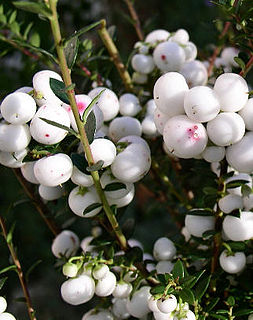
Gaultheria mucronata, the prickly heath, is a species of flowering plant in the family Ericaceae, native to southern Argentina and Chile.

Ligularia przewalskii (Maxim.) Diels, also called Przewalski's leopardplant and Przewalski's golden ray, is a species of 1.5–2 m (4.9–6.6 ft) tall perennial herbaceous plant in the genus Ligularia and the family Asteraceae, native to damp places in Mongolia and Northern China and named after Nikolai Przhevalsky. It used to be called Senecio przewalskii Maxim. Przewalski's Ligularia is a popular ornamental plant grown for its large, deeply cut foliage and its tall spike-like inflorescences with bright yellow composite flowers blooming from July to August.

Jasminum humile, the Italian jasmine or yellow jasmine, is a species of flowering plant in the family Oleaceae, native to Afghanistan, Tajikistan, Pakistan, Nepal, Burma (Myanmar), the Himalayas and south west China. The species is widely cultivated and reportedly naturalized in Greece, Sicily and the former Yugoslavia.

Bistorta amplexicaulis, the red bistort or mountain fleece, is a species of flowering plant in the buckwheat family, native to China, the Himalayas, and Pakistan. It is a damp-loving herbaceous perennial growing to 1.2 m (4 ft) tall and wide, with heart-shaped pointed leaves, downy beneath, and narrow spikes of rose-red or white flowers in summer.

Verbena rigida, known as slender vervain or tuberous vervain, is a flowering herbaceous perennial plant in the family Verbenaceae. It is native to Brazil and Argentina, and is not fully hardy in temperate climates, where consequently it is grown from seed as an annual.
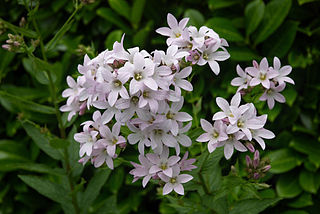
Campanula lactiflora, the milky bellflower, is a species of flowering plant in the genus Campanula of the family Campanulaceae, native to Turkey and the Caucasus. It is a medium-sized herbaceous perennial growing to 1.2 m, with narrow, toothed leaves 5–

Cotinus obovatus syn. C. americanus, the American smoketree, chittamwood or American smokewood, is a rare species of flowering plant in the genus Cotinus of the family Anacardiaceae, native to Oklahoma, Texas, Arkansas, Missouri, Alabama and Tennessee. It is a deciduous, conical shrub growing to 10 m (33 ft) tall by 8 m (26 ft) broad, with oval leaves up to 12 cm (5 in) long. It produces panicles of pink-grey flowers in summer, and its foliage turns a brilliant scarlet in autumn; considered by many to be the most intense fall color of any tree. The smokey effect derives from the clusters of hairs on the spent flower stalks. It is highly sought after and cultivated in botanical gardens worldwide.
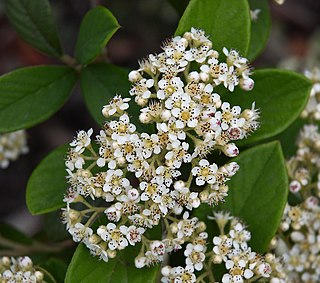
Cotoneaster lacteus, the late cotoneaster or milkflower cotoneaster, is a species of flowering plant in the genus Cotoneaster of the family Rosaceae, native to the Yunnan Province of China. It is a large evergreen shrub growing to 4 m (13 ft) tall and wide. Clusters of white flowers are followed by masses of small, globose, red fruits (pomes) in autumn. Unusually for this genus, the fruits are avoided by birds, hence garden escapes are rare, and the fruit persists on the plant throughout the winter.

Echinops bannaticus, known as the blue globe-thistle, is a species of flowering plant in the sunflower family, native to southeastern Europe. It is an herbaceous perennial thistle, growing to 120 cm (47 in), with prickly foliage and spherical blue flower heads in summer.






















